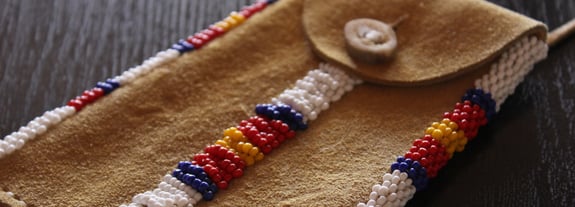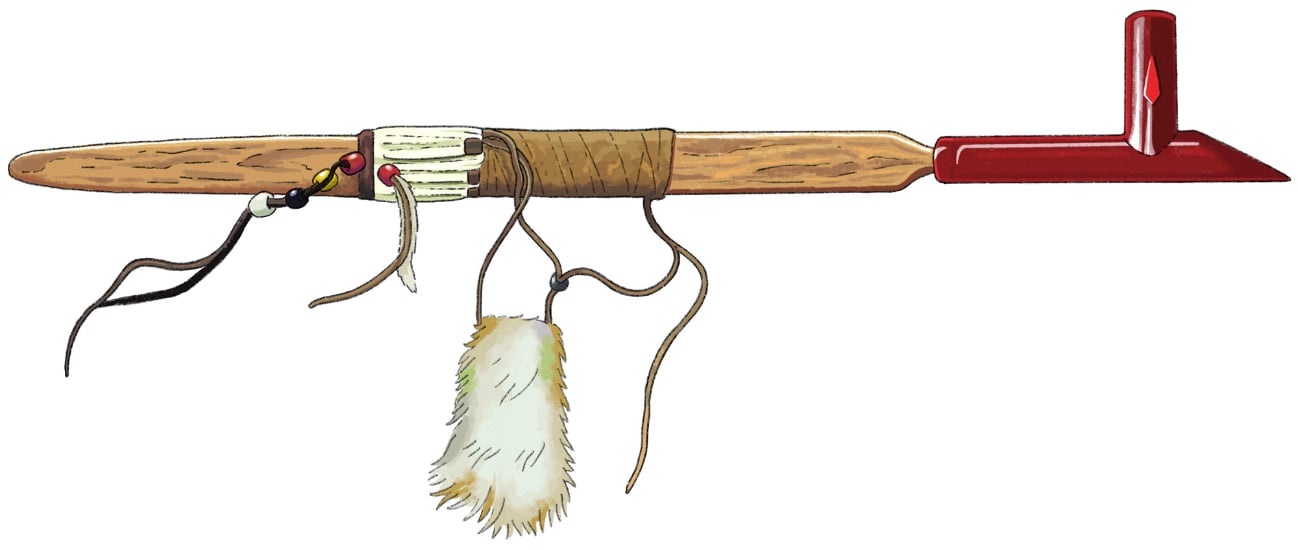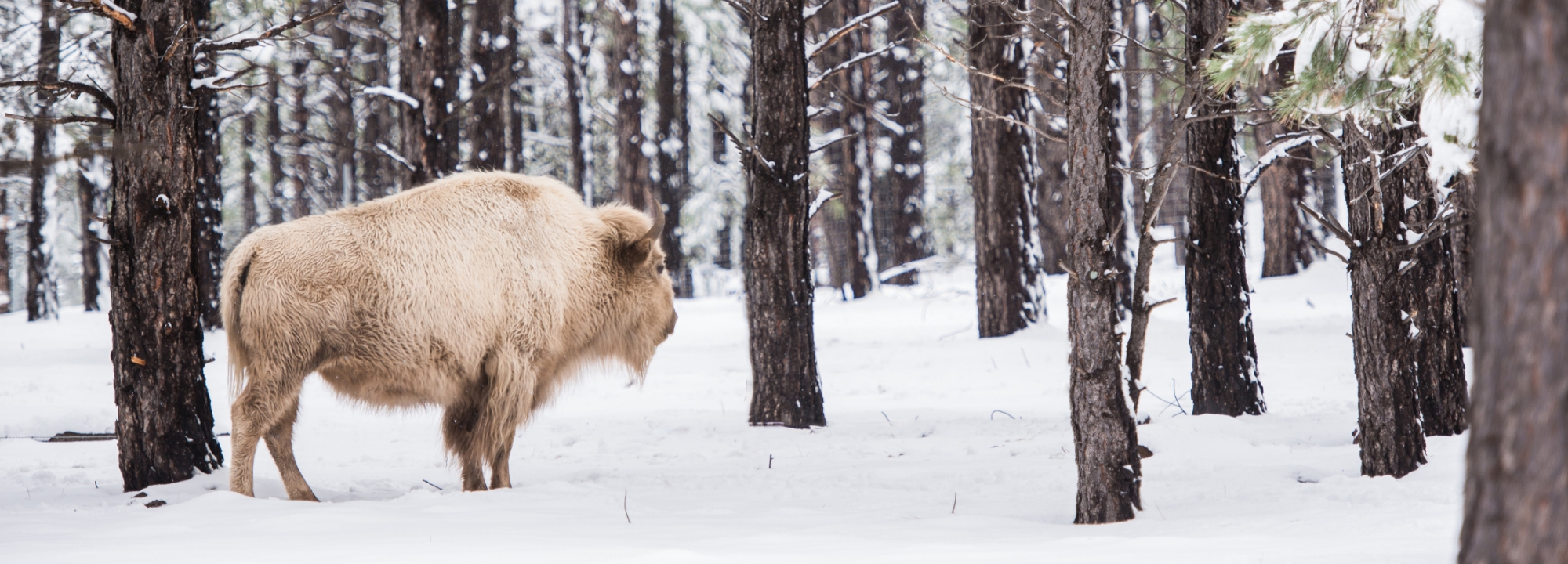
Sacred Pipe
For the Lakota and Dakota people, čhaŋnúŋpa (sacred pipe) is a key part of our spirituality and culture.
ČHAŊNÚŊPA
With a positive heart and intention, the smoke from the sacred pipe connects us to the spirit world and carries our prayers and thoughts upwards.
In pipe ceremonies, we use ċanśaśa in the čhaŋnúŋpa. As the ċanśaśa is lit by fire, then drawn into our mouth. Our prayers, thoughts and offerings mix with the smoke. As we exhale, the smoke carries these offerings upwards to the spirit world.

Each part of the pipe symbolizes our relationship with each part of the world:
- Plants (stem)
- Animals (bowl)
- Humans (tobacco)
- Elements (breath)
- Spiritual beings (smoke)
KEEPER OF THE SACRED PIPE
THE STORY OF WHITE BUFFALO CALF WOMAN AND THE GIFT OF THE PIPE
This story, as told by Chief Arvol Looking Horse, tells how the čhaŋnúŋpa (sacred pipe) came to our people and teaches us how ċanśaśa and the sacred pipe work together to heal mind, body, spirit and connection to Mother Earth.

At that time, not long after the Flood, the People still followed the buffalo, but they had forgotten the Creator and the teachings of the buffalo. They were trying to control one another, be more than who they are. The buffalo disappeared, and the People were starving and crying. They grew too weak even to move camp, and so they sent out scouts to look for buffalo or other game. But always they returned empty-handed.
Then one day they sent out two scouts, who saw not even a rabbit the whole day. Dejected, they started back to camp from their failed hunt, traveling through the woods and rolling hills, northeast of the sacred Black Hills.
It was a beautiful day, the sky blue with few white clouds. As the two scouts were returning to the camp, they saw a woman come over a hill, and they watched in awe, wondering what a woman alone could be doing out here in the middle of nowhere. Dressed in a beautiful white buckskin dress, this woman approached them carrying a bundle in her arms. One of the scouts, seeing the beauty of the woman, felt lust for her. He said, “She’s so beautiful. I think I’ll take her for a wife.”
As they were talking, she came closer and she pointed to the one with the bad thoughts, as if beckoning him. He went towards her, thinking to take her.
The other scout tried to stop him saying,“She’s sent by the Great Spirit. She’s the answer to the People’s prayers for help. She must be a Spirit-woman. Don’t approach her with such thoughts on your mind.” But the lustful scout refused to listen.
As he reached for the woman, a swirling cloud suddenly came down and enveloped him. When the cloud lifted, he was laying there at her feet all bones, a skeleton with snakes crawling from his head.
Then the Spirit-woman pointed to the other scout, who trembled before her, and she said, “Go, tell your People what you have seen here. Tell them to build an altar of sage and cherry branches, and also to put up a great tipi, and I will come tomorrow from where the sun sets. Tell them I have a great gift to give them, a gift kept in this sacred bundle. And she told him, “Tell them just what I have said. Don’t make more than what it is and don’t make less than what it is!”
The scout thanked her for the Message. Still filled with fear, he backed slowly away from the woman, then ran back to the camp and told the People what had happened and what the Spirit-woman had told them—no more, no less.
In the camp, the Buffalo People followed the instructions given by the scout and put up their tipi and prepared the altar with sage and cherry branches to each cardinal direction. Behold—the very next day, as she had promised, she returned out of the sunset. As she moved toward them, carrying the Bundle in her outstretched arms, she sang a beautiful song that we still sing today. Walking clockwise around the altar of sage and cherry branches, she set down the Sacred Bundle in the altar, then opened it to reveal the sacred caŋnuŋpa. She told them, “This caŋnuŋpa, you will make direct personal contact with Wakaŋ Taŋkaŋ.”
She said, “Following the way of this sacred caŋnuŋpa, you will walk in a sacred way upon the Earth, for the Earth is your grandmother and your mother and she is sacred.” She told them, “The red stone of the caŋnuŋpa’s bowl represents the blood of the People, and it also represents the female. And the wooden stem represents the Tree of Life, and it also represents the male. The Tree of Life also represents the root of our ancestors, and as this Tree grows so does the spirit of the people.” She said, “When you put the caŋnuŋpa’s bowl and stem together, you connect the world above and the world below. The only time the caŋnuŋpa is put together is when you are in prayer. And when you pray with the caŋnuŋpa, humble yourself. Present your prayers to all four Sacred Directions, and then pray to the Great Spirit above and Mother Earth below. Sing your songs, and pray for life, peace, harmony and happiness.”
She warned, “You must have a good heart and a good mind to go to the ceremonies. Honor the Sacred Places, the Sacred Ceremonies and the Sacred Sites. Each Sacred Site is an altar to the Great Spirit. Gather there often and pray the prayers and sing the songs I have taught you. In time, you will understand the meaning of the Seven Sacred Rites that come with this sacred bundle.”
She left in a clockwise motion returning to where the sun sets. On top of the hill, she stopped and looked back, then rolled over and became a young beautiful black buffalo. The second time she was a red buffalo, then a yellow buckskin buffalo and finally a white buffalo. This is where she received her name Pte Saŋ Wiŋ, and our Seven Rites were given.
Taken with respect from Sacred Willow: Keeping Tobacco Traditional





